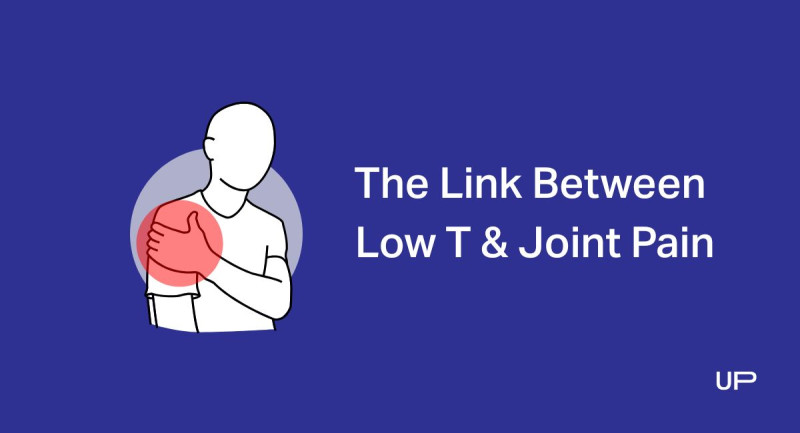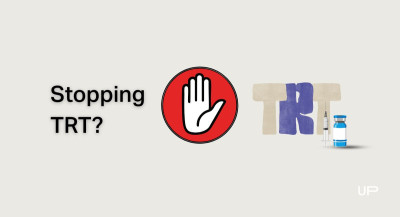Understanding The Link Between Low Testosterone & Joint Pain


If you’re dealing with persistent joint pain — in your knees, shoulders, hips, or hands — and there’s no clear injury or diagnosis, low testosterone might be part of the picture. While it’s not the first thing most men in Canada consider, testosterone plays a key role in supporting bone and joint health.

Low testosterone (often called “low T”) has been linked to increased pain sensitivity, inflammation, and reduced tissue support — all of which can affect how your joints feel and function. For men currently using or exploring testosterone replacement therapy (TRT) in Canada, understanding this connection is especially important. Knowing whether your hormone levels could be contributing to joint pain helps you ask better questions and get the right care.
Topics covered in this article:
- How Testosterone Supports Muscles, Bones & Joints
- What the Research Shows About Low Testosterone and Joint Disorders
- Why Low Testosterone Might Contribute to Joint Pain
- When Testosterone Therapy Might Help and When It Might Not
- Lifestyle and Medical Steps You Should Consider in Canada
- UPGUYS’ Approach to Low T and Musculoskeletal Health
- Conclusion
- References
How Testosterone Supports Muscles, Bones & Joints
Testosterone plays a key role in musculoskeletal health by interacting with muscle, bone, cartilage, and joint tissues. Its effects are mediated through the androgen receptor (AR) and include both direct and indirect mechanisms.

Key functions of testosterone:
- It promotes osteoblast differentiation and activity in bone tissue, supporting bone mineral density and strength.
- It inhibits the formation and activity of osteoclasts (cells responsible for bone resorption), helping maintain bone integrity.
- Androgen receptors are present in chondrocytes (cartilage‑forming cells) and within joint tissues, suggesting testosterone may influence cartilage health and repair.
- Testosterone enhances muscle mass and strength, which in turn helps support joints by reducing mechanical stress and improving stability.
- By reducing fat mass and modulating inflammation (via cytokines like IL‑6 and TNF‑α), testosterone indirectly supports joint health.
Because testosterone affects multiple pathways—from bone density and muscle strength to cartilage and joint support—it helps explain why men with lower testosterone may report more joint discomfort or musculoskeletal issues when other causes are ruled out.
What the Research Shows About Low Testosterone and Joint Disorders
Research into the relationship between low testosterone and joint disorders is emerging and intriguing — but it also has important limitations. Key findings include:
- Several observational studies show that men with lower serum testosterone levels have a higher prevalence of osteoarthritis (OA). For instance, a study found low testosterone was significantly associated with increased OA risk (OR ≈ 1.22, 95% CI 1.02–1.46).
- Preclinical animal models suggest that testosterone may have protective effects on cartilage and joint pain sensitivity, but human data are limited.
- Interventional trials of testosterone replacement therapy (TRT) looking at joint pain outcomes are still small and inconclusive: one 6‑month study found reductions in reported joint pain among men receiving TRT, but no significant difference compared to placebo.
- Importantly, these findings are associations, not proofs of causation. Low testosterone may contribute to joint issues, but joint disorders also may impact hormone levels, or both may stem from shared underlying factors like obesity and aging.
In short, the evidence points toward a linked relationship between hormone health and joint health, but it does not support TRT exclusively for treating joint disorders. Proper medical evaluation and a holistic approach remain essential.
Why Low Testosterone Might Contribute to Joint Pain
Low testosterone (low T) may influence joint pain through multiple interconnected pathways. The research points to several mechanisms that help explain this possible relationship:
- Increased inflammation: Men with lower testosterone levels tend to have higher levels of pro‑inflammatory markers such as interleukin‑6 (IL‑6) and tumour‑necrosis‑factor‑α (TNF‑α), both known to accelerate cartilage breakdown and joint degeneration.
- Reduced cartilage and bone support: Testosterone receptors have been found in chondrocytes and cartilage tissue, and experimental data suggest that testosterone may promote matrix synthesis and slow degradation, supporting joint integrity.
- Obesity and metabolic burden: Low‑T often overlaps with increased fat mass, insulin resistance, and metabolic syndrome—conditions that elevate joint stress and inflammatory load.
- Muscle weakness and altered movement patterns: Testosterone helps maintain muscle strength and mass. When T levels are low, decreased muscle support around joints may lead to greater mechanical stress, altered gait or posture, and more joint strain.
Together, these factors create a scenario where low testosterone may not directly cause joint pain but could contribute significantly to joint health decline. Recognizing this connection helps frame why joint discomfort sometimes shows up alongside other low‑T symptoms and why men exploring testosterone replacement therapy (TRT) in Canada should consider joint health in their broader evaluation.
When Testosterone Therapy Might Help and When It Might Not
Testosterone therapy can play a role in joint health, but it isn’t a magic fix for every kind of joint pain. Understanding when it might be beneficial and when other factors are at play is key to setting realistic expectations.
Here’s what the science and current medical thinking suggest:
- TRT may help when low testosterone is clearly diagnosed: Men with documented hypogonadism who also experience joint discomfort might see some improvement in symptoms after starting TRT. Some studies suggest benefits like improved pain tolerance and reduced inflammation in this group.
- Joint pain from arthritis, injury, or wear and tear may have other root causes: If the joint pain is mechanical (such as osteoarthritis), autoimmune (like rheumatoid arthritis), or caused by long-term degeneration, low testosterone may not be the main issue. TRT might not provide much relief unless combined with other treatments.
- The research on TRT for joint pain is still evolving: While observational studies link low testosterone to joint issues, most clinical trials don’t yet confirm that TRT significantly improves joint pain on its own. More research is needed before making it a go-to solution for musculoskeletal problems.
The bottom line: testosterone replacement therapy can be helpful for the right patient, but it works best when prescribed based on a full evaluation of hormone levels and joint health, not just one or the other.

Lifestyle and Medical Steps You Should Consider in Canada
If you’re experiencing unexplained joint pain and suspect low testosterone could be involved, there are practical steps you can take to support your health and get the right diagnosis. These steps combine proven lifestyle strategies with proper medical guidance.
Start with the fundamentals:
- Build or maintain muscle mass through strength training
- Manage your weight to reduce joint stress
- Prioritize anti-inflammatory nutrition and adequate protein
- Ensure sufficient vitamin D and calcium intake
- Stay consistently active without overloading the joints
Pursue a thorough medical evaluation:
- Ask your doctor about imaging if joint damage or arthritis is suspected
- Get referred to a rheumatologist if autoimmune conditions are possible
- Request a testosterone panel, including total and free testosterone levels, ideally measured in the morning
If considering TRT in Canada, make sure to:
- Discuss your eligibility based on symptoms and bloodwork
- Understand the available TRT forms (injections, gels, etc.) and dosing options
- Plan for ongoing follow-up to monitor hormone levels and side effects
- Set realistic expectations about what TRT can and cannot improve
By combining lifestyle changes with proper testing and expert medical advice, you’ll be better equipped to manage joint pain—whether or not testosterone is the missing piece.
UPGUYS’ Approach to Low T and Musculoskeletal Health
At UPGUYS, men across Canada can access licensed doctors who evaluate low testosterone in the context of your overall health, including concerns like joint discomfort.

Here’s how we help:
- Professional assessment: Our Canadian physicians review your symptoms, including energy, libido, and joint-related concerns, and can order lab tests to check testosterone levels.
- No-cost lab requisitions: If medically appropriate, we’ll provide bloodwork requisitions at no extra charge to help determine whether low testosterone is a contributing factor.
- Doctor-supervised treatment: If TRT is confirmed as the right path, we offer prescription delivery across Canada at no cost—no consultation fees, no shipping fees.
- Ongoing monitoring: We provide follow-up care and regular check-ins to ensure your treatment stays safe, effective, and tailored to your needs.
TRT is never one-size-fits-all. UPGUYS is here to help you make an informed, medically sound decision.
Conclusion
Joint pain can have many causes, and low testosterone is just one potential factor. For men in Canada navigating both unexplained aches and possible signs of hormone imbalance, understanding how testosterone impacts bone, muscle, and inflammation is worth exploring.
Testosterone replacement therapy (TRT) in Canada may help if you have clinically low T and your doctor determines it’s contributing to your joint symptoms. But it’s not a magic fix—and it’s not a substitute for joint-specific care when arthritis, injury, or autoimmune conditions are at play.
The bottom line: don’t guess. Get tested, talk to a qualified healthcare provider, and approach treatment with realistic expectations. Your long-term joint and hormonal health are worth the right plan, not shortcuts.
References
UPGUYS has strict sourcing guidelines to ensure our content is accurate and current. We rely on peer-reviewed studies, academic research institutions, and medical associations. We strive to use primary sources and refrain from using tertiary references.- Lower serum testosterone is associated with increased likelihood of arthritis, PubMed,
https://pubmed.ncbi.nlm.nih.gov/37935765/ - Correlation between low testosterone levels and the risk of osteoarthritis: a cross-sectional analysis of NHANES data (2011–2016), BMC,
https://bmcmusculoskeletdisord.biomedcentral.com/articles/10.1186/s12891-024-08272-6 - A randomized, double-blind, placebo-controlled trial of testosterone for treatment of postmenopausal women with aromatase inhibitor-induced arthralgias: Alliance study A221102, PubMed,
https://pubmed.ncbi.nlm.nih.gov/32372176/ - Testosterone protects against the development of widespread muscle pain in mice. PubMed,
https://pubmed.ncbi.nlm.nih.gov/32658149/ - Testosterone and Bone Health in Men: A Narrative Review, PubMed,
https://pubmed.ncbi.nlm.nih.gov/33540526/ - Testosterone and Bone Health in Men: A Narrative Review, MDPI,
https://www.mdpi.com/2077-0383/10/3/530 - Estrogen and testosterone use different cellular pathways to inhibit osteoclastogenesis and bone resorption, PubMed,
https://pubmed.ncbi.nlm.nih.gov/16294275/ - Androgens and Androgen Receptor Actions on Bone Health and Disease: From Androgen Deficiency to Androgen Therapy, PubMed,
https://pubmed.ncbi.nlm.nih.gov/31731497/
This article is written for informational purposes only and does not constitute medical advice. The information provided in the articles cannot and should not replace advice from a healthcare professional. Talk to your healthcare provider about any physical or mental health concerns or the risks and benefits of any treatment or medication.





